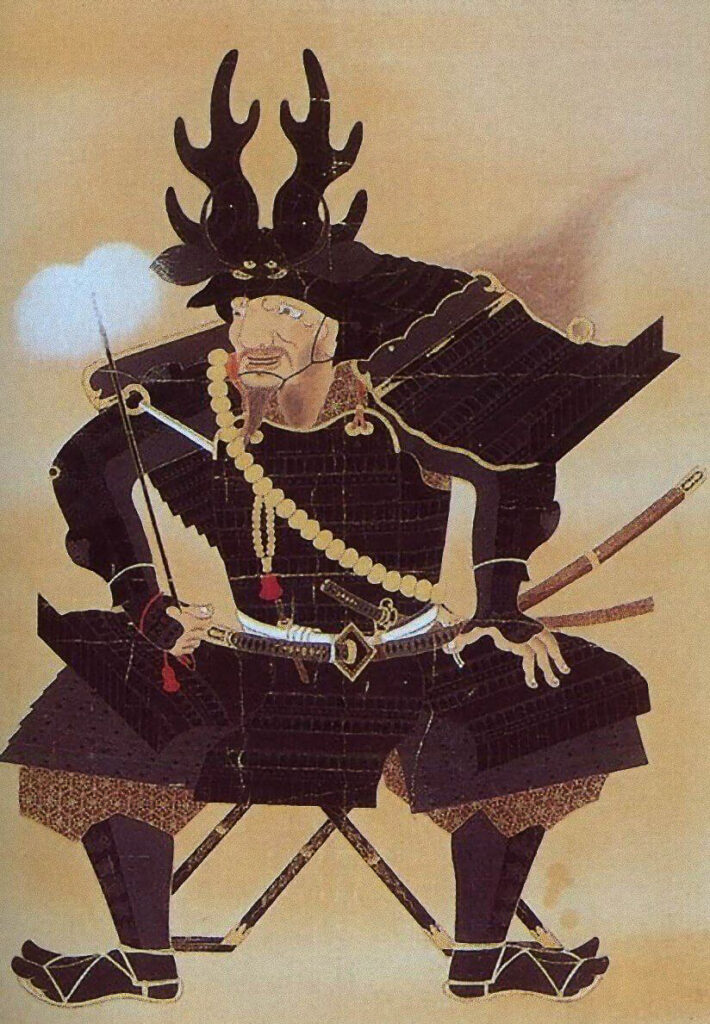

1548-1610
本多忠勝 Honda Tadakatsu
Exploring the Legacy of Honda Tadakatsu: A Samurai Warrior and Visionary Leader
Honda Tadakatsu was born in Mikawa (present-day Nishikurazen-cho, Okazaki City, Aichi Prefecture) and served Tokugawa Ieyasu from his childhood, contributing to Ieyasu’s unification of Japan. He was a military commander who excelled in valor among his vassals, and as one of the Four Heavenly Kings of the Tokugawa, he left his name on many battlefields.
Tadakatsu’s First Battle
Tadakatsu was born in 1548 as the eldest son of Honda Tadatoki, who served the Matsudaira family (the main Tokugawa family) for generations. His nickname was Heihachiro. His father, Tadataka, was killed in a battle when Tadakatsu was two years old. Therefore, Tadakatsu was raised by his uncle, Honda Tadamasa, who was a very strict man. Tadakatsu’s first battle was at the age of 13, an age that would be unthinkable today. This was serious competition in the Warring States period.
What is even more surprising is that Tadakatsu was 14 years old when he first took the head. Tadakatsu was the type of person who showed his true potential in war. It was only on the battlefield that he could display his abilities to the fullest. His reputation as a general who rampaged across the battlefield grew.
His Successes
Honda Tadakatsu’s exploits were admired by both friend and foe alike. While he had a dynamic personality, he respected those who excelled in valor and paid homage to them even if they were his enemies. It is said that he went into a battle 57 times and never suffered a single wound. His name is said to have come from the phrase “only win,” but the reason he was able to go into battle without a single wound may be that he repeatedly fought actual battles, improved his armor, and made every effort to make it lighter and easier to move so that he would live up to his name.
His Trademark
The “deer-horn helmet” and the “dragonfly cutter” came to be known as his trademarks.
First, Tadakatsu’s helmet “Kazuno Wakidate Kabuto,” or Japanese armor (yoroi/kabuto), is a simple black helmet. His helmet is famous for its deer horn flanks. There are various theories as to why deer horns were used as the side of the helmet. When Yoshimoto Imagawa was shot in the Battle of Okehazama and Ieyasu’s army had to immediately return to Okazaki Castle, Tadakatsu found that the river was swollen, and he could not cross. At that moment, a deer appeared, and when he was watching the deer also trying to cross to the opposite bank, he found shallow water at a certain point and crossed the river. Thanks to this, the deer was able to return safely to Mikawa. Since then, Tadakatsu made up his mind to “protect Ieyasu-dono for the rest of his life like the deer did that one time,” and made a helmet out of the deer’s horns. Deers have also been cherished as messengers of the gods since ancient times. There are various theories as to why deers were regarded as messengers of the gods, but in mountainous Japan, the deer’s ability to run through steep mountains may have portrayed them as animals with mystical powers. In addition to his military prowess, Honda Tadakatsu was also attractive because of his large figure as a man, which is probably the reason why he is still popular today as a military commander who attracts many people.
Next is the spear of “Dragonfly Cutter. It is said that the name “dragonfly” came from the fact that a dragonfly flew over and as soon as it landed on the tip of the spear, it was cut in half. He was also a spearman, and it is said that his skill was such that he could cut a dragonfly in mid-air. A spear is essentially a utilitarian tool, used for striking and thrusting rather than cutting. Many are sturdy, heavy, and made to be martial, but the tip of a tonbo cutter weighs less than 500 grams, about half the weight of the tip of a regular spear. Thin and light, it is so sharp that it can cut off an insect just by touching it. Thus, Tadakatsu, the owner of the famous spear “Dragonfly Cutter,” and the man who never suffered a wound in 57 battles during his life, was truly a warrior of the Warring States period.
Relationship between Tadakatsu and the Tokugawa family: Loyalty to his lord
Tadakatsu was always present at important battles of the Tokugawa family. In the Battle of Mikatagahara against Takeda Shingen, Tadakatsu served as Nobushige (a commander who was in the rear to prevent the enemy from pursuing his army when it retreated) and broke through the enemy to escape from the battlefield. His bravery was so admired by the Takeda forces that a graffiti was created saying, “Too much for Ieyasu is not enough, too much for Honda Heihachi is not enough.” He was praised by Nobunaga Oda as “a military commander with real grace and a powerful core.” In a battle against Toyotomi Hideyoshi, Tadakatsu’s fearless action of provoking his opponent to drink water from his beloved horse was praised by his enemy Hideyoshi as “the bravest warrior in Japan, ancient and modern.” Tadakatsu did not allow his enemies to be killed without consideration and remained loyal to his lord. In short, Honda Tadakatsu was a man without hesitation. His principles of action were simple and powerful. Because he died alongside his lord and remained loyal to his lord, he is called a samurai.
Tadakatsu as a Daimyo
Tadakatsu was also incredible as a daimyo. He is regarded as a great lord who actively reorganized the castle town and laid the foundation for the current development of Kuwana City. It is surprising that Tadakatsu, a professional fighter, had excellent administrative skills, but it is quite natural when you think about it. To survive on the battlefield, bravery alone is not enough, rational thinking is necessary. You must always find the best solution for the situation. Tadakatsu, who did not suffer a single wound in 57 battles during his lifetime, demonstrated rationality in his administrative skills as well.
.
.
.




